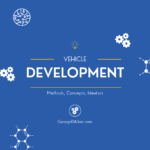New Occupant Safety in Automotive Systems

Occupant Safety
Introduction: Occupant Safety stands as a paramount concern in the realm of automotive design and engineering. As vehicles evolve with technological advancements, so do the Vehicle features (comprised of various systems) dedicated to safeguarding those within them. In this article, we delve into the intricate world of occupant safety within automotive systems development, exploring its significance, methodologies, practical applications, benefits, and challenges.
Importance of Occupant Safety:
The fundamental goal of Occupant Safety features in vehicles is clear: to mitigate injury and protect lives in the event of a collision or accident. From seatbelts and airbags to more advanced collision avoidance systems and autonomous driving technologies, every innovation aims to enhance the survivability and well-being of vehicle occupants. This relentless pursuit of safety underscores the moral obligation and legal responsibility of automotive manufacturers to prioritize occupant protection in their products.
Occupant Safety Definition:
In general and with specific disclosures for each particular Vehicle Function addressing intended use cases, the Occupant Safety concept can be defined as: Unconditional (safe) state of occupant(s) within and during utilization of the vehicle in terms of physical safety, meaning injury free. It can be detected, monitored and communicated.
In the context of autonomous vehicle fleets, Occupant Safety becomes paramount as passengers have limited control over the vehicle’s systems and subsystems. Consequently, this falls squarely on the vehicle manufacturer to ensure the precise specification and functionality of these systems.
Systems Methodologies in Product Development:
A crucial aspect of advancing occupant safety lies in the meticulous methodologies employed throughout the product development cycle. Systems engineering approaches play a pivotal role, ensuring a comprehensive understanding of the interplay between various components and subsystems within a vehicle. By adopting systems thinking, engineers can design holistic solutions that address occupant safety from multiple angles, considering factors such as crashworthiness, structural integrity, sensor integration, and human-machine interaction.
Referencing the Systems Engineering Method: https://georgedallen.com/unraveling-the-uniqueness-of-systems-engineering-in-the-automotive-realm/
Practical Applications and Benefits:
The practical applications of occupant safety systems are manifold coming from Active and Passive Safety Vehicle features, ranging from notification chimes and passive restraints like seatbelts and airbags to active technologies such as pre-collision warning systems and lane departure alerts. These innovations not only reduce the likelihood of injuries but also enhance comfort and convenience for occupants. Moreover, advancements in materials science and manufacturing techniques have led to lighter yet stronger vehicle structures, further improving crash performance and fuel efficiency.
Referencing Passive Occupant Safety: https://georgedallen.com/enhancing-road-safety-the-evolution-of-passive-vehicle-occupant-safety-systems/
Challenges in Implementation:
Despite the significant strides made in occupant safety, several challenges persist in its implementation. Chief among these is the need for seamless integration of diverse technologies while maintaining cost-effectiveness and reliability. Additionally, ensuring compatibility and standardization across different vehicle models and manufacturers remains a complex endeavor. Furthermore, as vehicles become increasingly interconnected and autonomous, new concerns emerge regarding cybersecurity and data privacy, adding layers of complexity to the safety equation.
Real-World Examples and Case Studies:
To illustrate the impact of occupant safety systems on the final product, let’s consider a real-world case study. The introduction of Electronic Stability Control (ESC) in vehicles has been credited with reducing the risk of fatal single-vehicle crashes by up to 50%. This technology utilizes sensors to detect and mitigate skidding or loss of control, significantly enhancing vehicle stability and preventing rollover accidents. Such tangible outcomes underscore the efficacy of investing in occupant safety technologies.
Conclusion
In conclusion, occupant safety stands as a cornerstone of automotive engineering, driving continuous innovation and improvement in vehicle design. By embracing systems methodologies and leveraging cutting-edge technologies, manufacturers can create safer vehicles that protect lives and enhance the overall driving experience. However, addressing the challenges inherent in this endeavor requires collaboration, ingenuity, and a steadfast commitment to advancing the state of the art in automotive safety.
References:
- National Highway Traffic Safety Administration (NHTSA) – https://www.nhtsa.gov/
- Society of Automotive Engineers (SAE) International – https://www.sae.org/
- Insurance Institute for Highway Safety (IIHS) – https://www.iihs.org/
- “Effectiveness of Electronic Stability Control in Reducing Real-World Crashes: A Literature Review” – https://www.researchgate.net/publication/5853306_The_Effectiveness_of_Electronic_Stability_Control_in_Reducing_Real-World_Crashes_A_Literature_Review#:~:text=A%20number%20of%20studies%20find,%2C%20fatal%20multi%2Dvehicle%20crashes.
About George D. Allen Consulting:
George D. Allen Consulting is a pioneering force in driving engineering excellence and innovation within the automotive industry. Led by George D. Allen, a seasoned engineering specialist with an illustrious background in occupant safety and systems development, the company is committed to revolutionizing engineering practices for businesses on the cusp of automotive technology. With a proven track record, tailored solutions, and an unwavering commitment to staying ahead of industry trends, George D. Allen Consulting partners with organizations to create a safer, smarter, and more innovative future. For more information, visit www.GeorgeDAllen.com.
Contact:
Website: www.GeorgeDAllen.com
Email: inquiry@GeorgeDAllen.com
Phone: 248-509-4188
Unlock your engineering potential today. Connect with us for a consultation.

